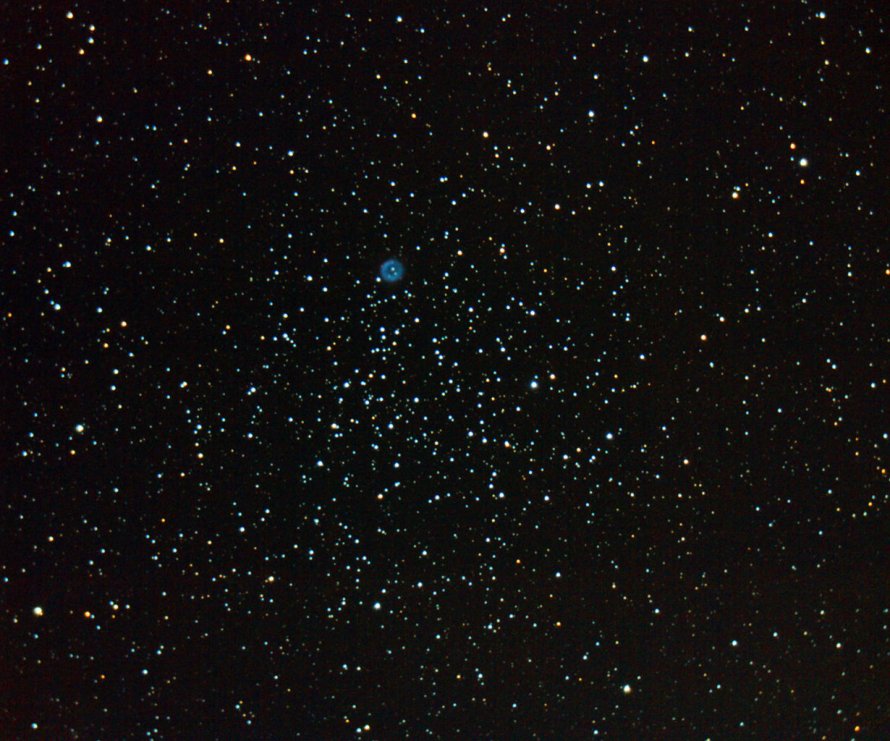M46 (NGC 2437)
Messier 46 (NGC 2437) is an open cluster located in the constellation Puppis, in the Orion Arm of the Milky Way Galaxy in the Local Group of galaxies. M46 is 2870 light years away from Earth.
M46 is best viewed during winter, is magnitude 5.9, and can be viewed with naked eye (barely). M46 is 16' in apparent size. For reference, the full moon is 30'.
Observing difficulty: Intermediate
- Name:
- Type:
- open cluster
- Constellation:
- Puppis
- NGC or IC:
- NGC 2437
- Magnitude:
- 5.9
- Viewing:
- naked eye (barely)
- Size:
- 16'
- Distance (light years):
- 2870 LY
- RA:
- 7h 41.8m
- Dec:
- -14 49'
- Season:
- winter
- Milky Way location:
- Orion Arm
- Galaxy group:
- Local Group
- Messier Marathon #:
- 24
- Contains:
- 500 stars
* The naked eye can see up to magnitude ~7-8 objects under ideal dark sky conditions.
An In-depth Exploration of an Open Star Cluster
Located in the southern constellation of Puppis, Messier 46 (M46) is an open star cluster teeming with a diverse assortment of stars. It offers a fantastic study of stellar evolution and is a favorite target for amateur astronomers. This article explores the historical background, physical properties, and observational aspects of M46, with special emphasis on its brightness and the ease with which it can be located and observed.
Historical Background
Messier 46 was discovered by Charles Messier, a French astronomer, on February 19, 1771. It was the 46th entry in his catalog of comet-like objects, which was designed to help comet hunters avoid confusing these static objects with the comets they were seeking. M46 is noteworthy because of its proximity to another Messier object, the planetary nebula M47. The pair can often be viewed in the same telescopic field of view, making for an intriguing observational challenge.
Physical Characteristics and Magnitude
M46 is one of the richer open clusters, hosting nearly 500 stars and situated approximately 5,400 light-years away from us. It spans about 30 light-years across. The cluster is quite young by astronomical standards, estimated to be about 300 million years old, and it provides astronomers with an excellent snapshot of stellar youth and formation.
The overall visual magnitude of M46 is approximately 6.1, making it a challenging object to view with the naked eye, but easily visible with binoculars or a small telescope from a dark sky location. The brightest individual stars within the cluster are of 10th magnitude.
Astronomical Importance
M46 is particularly interesting because it appears to contain a planetary nebula, NGC 2438. However, this nebula is probably a foreground object and not physically associated with the cluster, as its velocity is different from the cluster's member stars. This setup provides a unique perspective on two different stages of stellar evolution - the young stars of the open cluster and the dying star at the center of the planetary nebula.
Finding and Observing M46
Finding M46 can be a bit of a challenge, especially for novice stargazers, as the constellation Puppis is relatively faint and is best seen from southern latitudes. It can be found by first locating the bright star Sirius in the constellation Canis Major. Moving about 12 degrees to the east and a little south will bring you to M46.
When viewed through a small telescope, M46 is a breathtaking sight. Its dense concentration of stars, along with the ghostly glow of NGC 2438, provides a captivating view. Using a larger telescope under dark skies, observers can resolve many of the cluster's fainter stars, enhancing the spectacle.



